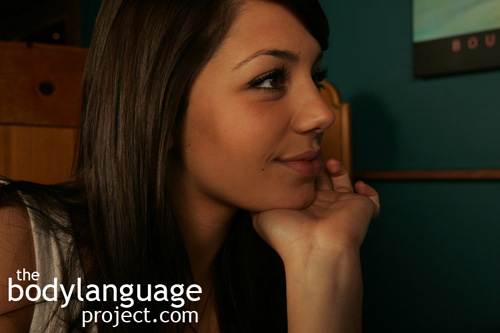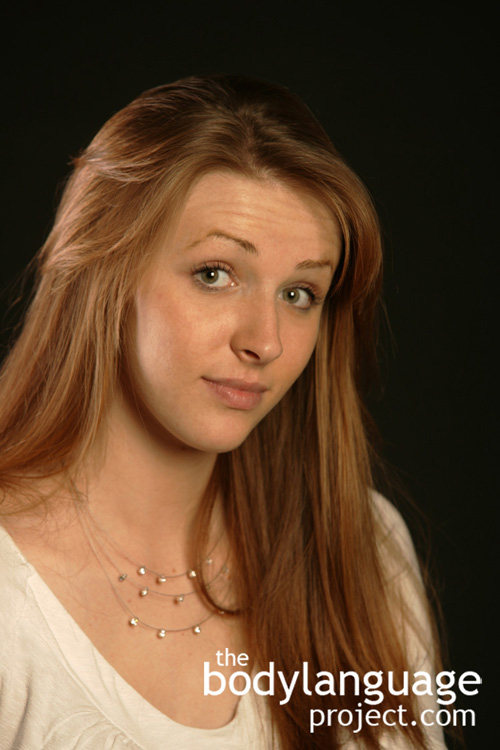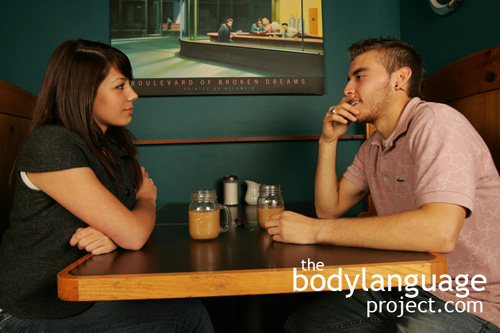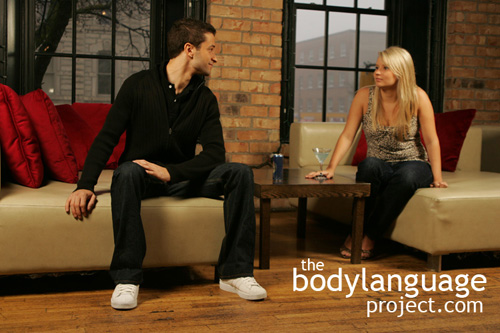We can tell if our boss autocratic if they are attached to the status artifacts around them. Their desk will be used as a barrier protecting them from intruders, they will have cleaver title markings on their desk or door, and usually have trophies or accolades on their walls. Their dress will be formal and expensive and their posture will be rigid and straight. Friendliness is the foe of the autocratic boss so he will keep you at arms length, keep conversations on task and hold expressionless faces. If you get out of line, he will use his body language to put you back in your place with harsh voice tones and eye contact. Often autocratic bosses are seen as unloving, unfriendly or inhumane. To get along with him, use body language that doesn’t undermine his status, allow him to maintain his power, never enter his personal space or move to his side of the desk without permission, don’t interrupt him, smile pleasantly, and keep conversations brief so as not to waste his time.
Tag Archive for Faces
How We Prefer To Orient Ourselves When Standing
by Chris Site Author • March 6, 2013 • 0 Comments
Most people would state that standing square, face-to-face was the most honest and trustworthy position people orient themselves in while speaking with someone, but they would only be half right. In fact, most Americans stand at forty-five degrees or at oblique angles to one another. Facing someone dead on, is how boxers square off to one another in the pre-show weigh-in or when two men near physical contact at a bar. The head on orientation is reserved for confrontation with just one exception. That is when two people are really comfortable with each other.
In confrontation people get really close to one another and stare into each others eyes as a signal of dominance. This stance has a basis in escape since it is much easier to exit left or right from a tilted position rather than one that squares you off to someone else. When we want to exit from a confrontational stance we need to pivot or shift first which requires more movement and puts is in peril. However, orienting at oblique angles mutually tells us that we aren’t trying to corner each other, but when confrontation is not a remote possibility, facing straight-on is a demonstration of extreme comfort and trust.
Other cultures don’t feel this way. Arabic cultures for example will speak with one another with their faces nearly touching, which isn’t rare, in fact it happens during normal conversation. Women in American cultures tolerate such closeness only from another woman. Men who do this to women will be perceived as sexually interested and be seen to be making a sexual come-on. If not welcomed closeness will be a threat and turn-off, and in an office situation, should definitely be avoided.
Undivided Attention
by Chris Site Author • March 6, 2013 • 0 Comments

An interested listener is focused on the entire person, their gestures, voice tone and the information delivered.
Meeting in crowded areas offers plenty of distractions, which in and of itself might lead one to belief that measuring attention would be difficult. However, the opposite is actually true; in other words, it’s easier to measure interest in busy places because the eye can be caught wondering. As we covered earlier in the chapter on eye language, we can verify interest based on where eyes are cast. The eyes tell where the body wants to be, and when the mind is fully engaged on the presentation, the focus will be on the speaker rather then what is going on around them.
Looking away rarely happens with someone who is completely engrossed in a conversation unless they do so to concentrate. We know from an earlier discussion, that faces are complicated making it difficult to process information. However absent of complex thought, we know that when someone looks away, it’s due to disinterest in the subject matter. Take for example, a very important news item appearing suddenly on television and the sequences of events that follow. First, we try to quiet a room so we have time to tune into the broadcast, next we locate the remote and turn the volume up loud enough so that even random noises don’t supersede the broadcast. Our eyes become fixated at the exclusion of anything else in the room and our ears become finely tuned to the voice of the broadcaster. When completely engaged, there is a fear of missing something important. This doesn’t just occur while watching television or movies, but can happen when in deep conversation, while reading something interesting or any other task for that matter. Any husband will tell you how easily it is to “tune” women out when watching sports!
An interested listener is focused on the entire person, their gestures, voice tone and the information delivered. For most, the picture they pick up about the speaker’s body language is subconscious, but it does help them form an overall impression of their honesty, integrity, emotionality and so forth. Therefore the focus doesn’t stop on the words alone, but on the entire message. An attentive listener is directed, having their bodies oriented toward the speaker, their arms open and apart willing to take information in, their legs will be crossed or open but aimed at the speaker, their head might be cocked to the side at forty five degrees showing interest, and any information they add will be appropriate to the given subject rather than off topic.
There will be times, when a fully attentive person will look away, down or about the room, but these ganders are few and brief, with the primary attention placed back on the speaker. It has been shown that up to eighty percent eye of contact is made while listening and about forty to sixty percent while speaking. Thus, we can measure the level of interest simply by making note of how often the person looks away. Someone that is bored will almost seem to look everywhere but at the speaker, or will appear to glaze over in an unblinking stare. Looking away is a subconscious indication that the other person is looking for an escape route – a way out of the conversation.
Perpetuating The Smile: On Mirroring And Smiling
by Chris Site Author • March 5, 2013 • 0 Comments
Smiling is contagious and often just by holding a smile others feel compelled to smile as well. Try an experiment for yourself and see just how hard it is to frown when viewing smiles or smile when viewing frowning. You will see that mirroring is a much more natural response whereas holding opposite expressions requires conscious thought. Flashing a smile at random strangers can flood their bodies with positive hormones and brighten their day. Even just holding a smile despite feeling down can help elevate your mood and make you feel better.
We see this exact same contagion with attitudes of those surrounding us. A famous skit on Saturday Night Live involves a character called “Debbie Downer.” The scene is set in a social gathering where the character, at each opportunity, offers a contrarian’s view to what is an otherwise a positive or neutral statement. The effect it has is potent and brings those around her down, hence her name. Persistent negative attitudes in others around us tend to drag down our moods, while optimistic attitudes tend to make us feel better. Although overly optimistic attitudes, just like overly pessimistic attitudes can lead to negative feelings about others as well.
Research has shown that our facial muscles tend to mirror what we see in others and that this reaction is subconscious. While it is possible to control our facial muscles by consciously over-ridding this tendency, most others will simply, by nature, imitate what they see in us. This is why it is so important to, both imitate smiles when seen, and to also avoid holding sour faces especially on initial meetings.
Let’s take the stereotypical example of a married couple; a wife and husband. After a long days work taking care of the children, the husband comes home from his long day with a scowl on his face and plops himself on the couch. He’s had a bad day, and so too has she. Their expressions feed of one another and their attitudes remains negative. What if the husband came home with good news and a big smile? Naturally, his wife would follow and they’d share a nice welcome, both parties willing. If one or the other fails to follow the lead, the entire mood would be soured by the frowning party. Both parties are therefore responsible for deciding the mood.
We often get caught up in daily rituals, especially at home, that we forget to put on a fake smile which is otherwise required at work. We know that we can’t get away with such crass behaviour while away from home and around strangers, so we put on a fake smile despite our mood, but once home we give our faces a break. We know instinctively that we can’t get away with a sour face in public because others will think poorly of us and won’t want to be around us. The freedom to express moods naturally in our own homes can be a blessing, but can also be a drag. Sometimes taking the extra effort can be rewarded so it’s worth a try, especially if the mood has been sour perpetually. So the advice follows that when people around you are in a bad mood, even at home, initiate the smile, hold it persistently and see what happens!
The Eyebrows In Communication
by Chris Site Author • March 5, 2013 • 0 Comments
The eyebrows are very active in conversation. They can furrow to show anger or be turned inward and down to show disgust or a crucial view. Even still, the eyebrows can be raised fully to express surprise or be singly raised and lower to indicate suspicion. One eyebrow raised and the other level or neutral is a widespread sign of skepticism or displeasure and is called the eyebrow cock but if done subtly with a slightly cocked head and a cheeky smile means “interesting”.
Disappointingly, very few actors have control over their eyebrows, and if you don’t believe me just watch for yourself. I’m not sure they could use their faces very efficiently even if they tried, as the use of eyebrows is not something that is easily consciously controlled. I have noticed that female television news anchors will flash away during most of their reports but men won’t. This is also the case with male actors who favour control, presumably to appear more dominant especially in lead roles.
Placement, size, and shape of the eyebrows also portray different meaning. Lower eyebrows appear more dominant whereas high eyebrows make for a more subordinate yet perpetually surprised look. Eyebrows that are turned in near the outside of the face also called “medially downturned” make the face appear more concerned or empathetic. Bushy eyebrows signal dominance, and thin brows remind us of children so appear more neotenous whereas the uni-brow where the eyebrow forms one single brow across both eyes appears archaic, unsophisticated and un-groomed.
The eyebrows also have a language all to themselves. The eyebrow raise, where the eyebrows come straight up and then back down in one motion, happens in speech to emphasis certain words, to punctuate a point or in accompaniment with questions. The eyebrows raise can also appear as a request for approval when unsure how our thoughts stand with others, or can even be meant as a measure to verify if what we have said is being understood. In this case, the eyebrows will come up and pause for a second and seek some sort of gesture of approval such as a head nod or vocal agreement before being lowered. If there is no approval, then we might see the “eyebrow hold” which is akin to the shrugging of the shoulders, indicating a lack of knowledge or even helplessness. Politicians and children do this often when they seek approval, it says “So, what do you think, have I don’t a good job?”
Other times the eyebrows will move almost continuously throughout a conversation when we really want to impress someone, flirt with them, or act particularly animated. If eyebrows are raised with a slight tilt of the head at the end of the sentence it is to check to see if the message was understood but if it is done with a slow raise of the head, it means disapproval saying “What you have just said, surprises me”. Disapproval is even stronger if the head is lowered with the lips pursed tightly accompanied by raised eyebrows. This signals a desire to end communication altogether.
Putting Your Best Side Forth
by Chris Site Author • March 5, 2013 • 0 Comments
We have always been told to put our best foot forward but it might be more advantageous to always put our best side forward instead. But what side really is our best? Is there really even a best side? You might be surprised to note that our faces do in fact have a good and bad side and it’s based on perspectives or how our minds view things. All but the most beautiful of people have some asymmetry in their faces. Meaning the left side of their face is not an exact mirror image of the right. For example, the eyes and mouth aren’t usually perfectly parallel, one eye might open wider than the other, we may have one check bone set higher than the other and so on.
To determine which side of your face is your best, begin by running a line from one eye to the other and then run a second line across the centre line of the mouth horizontally. Obviously this is best done with a still print photograph with the face head on. Having drawn our lines we now need to explain our findings, and to do so we draw from how we view perspective, landscapes in particular. Take any landscape drawing or photograph and note that as we look “into” the photograph, distant lines converge on each other, producing the effect of appearing smaller. Objects nearby, that appear larger, have lines that diverge. Objects that appear close also seem to slop or drop as they near us, again giving us the impression that they are larger. Obviously, in reality, objects neither increase nor decrease in size as our distance to them changes, it is merely a function of perspective.
Our best side therefore, is the side which lends itself best according to the rules of perspective. When we look at a face at any other angle besides head-on, the best view will be that which has the greatest distance between the edge of the mouth and the corner of the eye since it produces the proper effect in lieu of distance and perspective. We expect to see a wider gap nearest us which then narrows as it moves away. Our mind prefers to see the distant eye as actually being further away and one of the ways it perceives this is for the line created through the center of the mouth and the line created through both eyes to converge, otherwise it becomes confused. This confusion is perceived as being less attractive. The greater the angle between the mouth and the eye, the stronger is the effect producing an even greater difference between a person’s good and bad side, since the effect is amplified. Naturally too, symmetrical faces will have no best or worst side as it pertains to perspective since either side will produce this correct effect.
Having this knowledge, take the time to examine your face to determine which side has the greatest separation from eye to mouth and when in conversations or in photographs be sure to orient that side toward the camera or toward your company. The effect might be subtle, but if you are posing for an important photograph or planning an important meeting, or auditioning for a movie role, it just might make your face that much more memorable.



